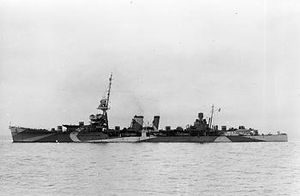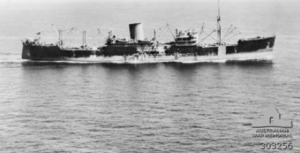HMS Durban facts for kids
class="infobox " style="float: right; clear: right; width: 315px; border-spacing: 2px; text-align: left; font-size: 90%;"
| colspan="2" style="text-align: center; font-size: 90%; line-height: 1.5em;" | 
|} HMS Durban was a special type of light cruiser called a Danae-class ship. She was built for the Royal Navy and launched on 29 May 1919. Durban officially joined the navy on 1 November 1921.
Contents
| History | |
|---|---|
| Name | HMS Durban |
| Ordered | September 1917 |
| Builder |
|
| Laid down | January 1918 |
| Launched | 29 May 1919 |
| Commissioned | 1 November 1921 |
| Fate | Sunk as breakwater, 9 June 1944 |
| General characteristics | |
| Class and type | Danae-class light cruiser |
| Displacement | 4,650 tons |
| Length | 472.5 ft (144.0 m) |
| Beam | 46.5 ft (14.2 m) |
| Draught | 14.5 ft (4.4 m) |
| Propulsion |
|
| Speed | 29 knots (54 km/h; 33 mph) |
| Range | 2,300 nautical miles (4,300 km; 2,600 mi) |
| Complement | 350 |
| Armament |
|
| Armour |
|
Durbans Early Adventures Around the World
When Durban was new in January 1922, she was sent to the China Station. This meant she was part of a group of ships protecting British interests in places like China.
In 1928, Durban moved to the North America and West Indies Station. She was based at the Royal Naval Dockyard in Bermuda. A famous person, Prince George, Duke of Kent, who was the fourth son of King George V, even served on Durban as a watch-keeping officer!
Durban returned to Britain in 1930. The next year, she joined the South Atlantic Division. By December 1933, another ship, York, took her place. Durban then sailed back to home waters. In March 1934, she went to Gibraltar to join the Mediterranean Fleet. She spent two years there before returning to Britain in September 1936. At this point, she was put into "reserve," which means she was stored and not actively used.
Durban in World War II
When Second World War started in September 1939, Durban was brought back into service. She joined the 9th Cruiser Squadron in the South Atlantic.
Patrolling the Indian Ocean
In March 1940, Durban was operating in the Indian Ocean. She then moved to the Eastern Fleet, which was based in Singapore. Here, she worked with her sister ships, Danae and Dauntless. Their job was to watch German merchant ships in the harbours of the Dutch East Indies. Durban patrolled the area near Padang.
On 10 November 1940, a Norwegian tanker called Ole Jacob reported being attacked. It was hit by a German raider named Atlantis. This happened between Ceylon and Sumatra. A group of ships, including Durban, Capetown, Canberra, and Westralia, quickly gathered to hunt for Atlantis. However, they couldn't find the German ship.
Escorting Convoys and Evacuations
In 1941, Durban and her sister ship Dragon were busy escorting convoys. These were groups of ships traveling together for safety. They sailed between Singapore and the Sunda Strait. In February, Durban escorted the large ocean liner Queen Mary into Singapore. This ship was carrying Second Australian Imperial Force troops for Malaya. They arrived on 18 February.
Later, in November, Durban escorted the troopship Zealandia into Singapore. She took over from the Australian cruiser Sydney, which had escorted Zealandia from Fremantle, Western Australia.
In February 1942, the Japanese began their attack on Singapore. Durban moved with the rest of the Eastern Fleet to Java. Durban was damaged by bombing before she could leave Singapore. But on 12 February, she and Kedah escorted two merchant ships, Empire Star and Gorgon, out of Singapore. They fought off Japanese air attacks for four hours!
The next day, this convoy, carrying thousands of people escaping Singapore, reached Tandjong Priok. This was the port for Batavia. Durban, with Admiral Thomas C. Hart on board, left on 16 February. She was escorting Plancius, which was carrying more refugees to Colombo.
Repairs and Final Mission
In Colombo, Durban had some temporary repairs. Then, she traveled all the way to New York, arriving in April. There, she had full repairs done. After that, Durban returned to Britain. More changes were made in Portsmouth between June and August. She then started escorting convoys from Britain to South Africa.
On 8 December 1942, the ship accidentally ran aground at the entrance to Mombasa harbour. After being pulled free, she was put in a drydock in Bombay for inspection. In February 1943, Durban was in New York again for repairs. By June, she was back in South Africa, docking at Simonstown. She then rejoined the Eastern Fleet.
In November, Durban returned to Britain one last time. She was then "paid off" into the reserve, meaning she was taken out of active service. She was chosen to be one of the ships that would be sunk on purpose. This was to create a protective wall for the Mulberry harbours. These were artificial harbours used to support the D-Day landings during the Battle of Normandy.
So, on 9 June 1944, Durban was scuttled (sunk on purpose). She became part of the Gooseberry 5 breakwater, helping to protect the artificial harbour off Ouistreham in France. Her wreck now lies in about 11 meters (36 feet) of water.



